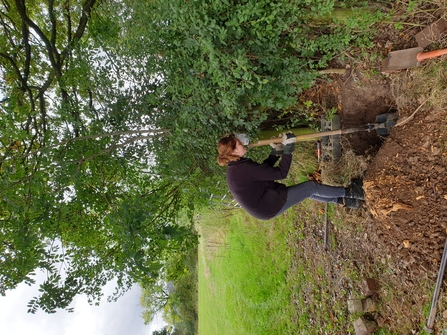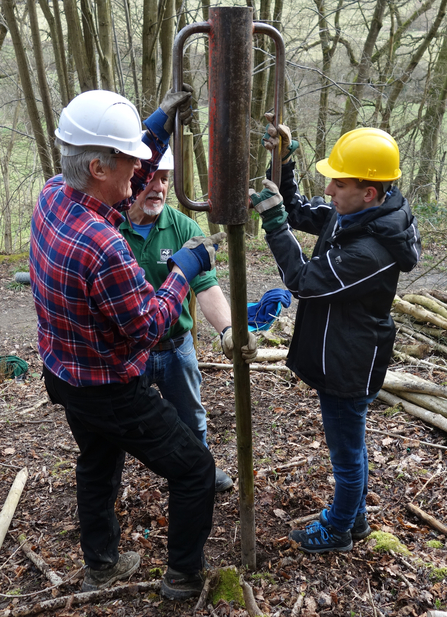One of the main reasons for wanting to do the traineeship was to learn and improve my practical skills, knowing that this is an essential part of many conservation roles. It’s safe to say that my practical skills were very much lacking and some of the tools I’ve used so far I wouldn’t have had a clue what they were for had I come across them on my own! I'd learned a few skills from volunteering at The Devil’s Spittleful work parties prior to starting the traineeship but I hadn’t realised how many other skills I would learn, especially in helping with maintenance. Not only do we carry out habitat management on our nature reserves but maintaining them for the public, to ensure that everything is usable and safe, is important too.
Keeping our reserves 'tip-top'
Tools by Ross Hoddinott/2020VISION

Digging a gatepost out by Iain Turbin
The problem with posts
Over the last five months I’ve dug out and replaced a fair few gateposts! At the beginning of the traineeship I did begin to wonder what I’d got myself in to – they seemed impossible to remove and it wasn't unusual to abandon them at the end of a long day, returning to them soon after to carry on. The problem is that the wood in the ground rots and the post begins to wobble; you'd think this would make it easy to remove! We start by digging around the post using a heavy bar to smash through the soil and make it loose.
The holes are dug so deep it feels never ending but the relief from finally finding the rotten end is a great feeling! Once they’re pulled out we can start to put in the new one, with all our fingers crossed that we’ve dug the hole deep enough for the new post to sit at the right height. Once we’re happy with this we ensure the post is straight using a spirit level and can refill the hole with the spoil we’d originally dug out. We then fit the gate fittings using a drill and hammer.
Much to my relief, the more gateposts I’ve fixed the easier I’m finding them – I’ve told myself it’s because I’m getting stronger and more skilled with the job. The reality - the ground conditions have been better at the more recent gatepost sites (but I’m going to pretend that’s not the case).
Ipsley Alders Marsh boardwalk by Ruthie Cooper
Busted boardwalks
Boardwalks are normally used in places that can be quite muddy and wet and because of this, they can often become broken and rotten. It’s often the bearers that need replacing - these are the bits that sit on the ground - but in order to get to them we need to remove the boardwalk itself. This requires using a hammer and crowbar to pull up the boardwalk. We then measure and cut our new bearer (thankfully, using the saw doesn’t feel like my arm is about to fall off after a few strokes any more) and fit this into place. We then drill new holes into the bearer and uprights and hammer nails in to keep it in place. After this we can put our boardwalk planks back on, reusing as many as we can – spacing them out can be a bit tricky and takes a lot of toing and froing to get it looking perfect. I find boardwalks a strangely satisfying job – normally we are covered in mud by the end of the task but I find that’s a sign of a good job done!

Volunteers bashing in a post by Ben Rees
Fun with fencing
Fencing is a common maintenance task, mainly to ensure that areas used for conservation grazing are kept secure for the livestock. I’m still learning exactly what I need to do. There are lots of different types of fences (who knew) - some with metal squares, some with wooden bars - and each one I've worked on has been a little different in what needs to be done.
One memory that springs to mind is a time myself and Meg were asked to finish a small fencing job at Lower Smite Farm. We started mid-afternoon and it seemed to take us ages to get to grips with what we needed to do. We joked that we’d still be working on it as it became dark – slowly we realised that what we’d been joking about was coming true and we managed to finish before we lost the light. Being able to laugh whilst completing more difficult tasks definitely helps us get through.
Fortunately, some fencing I’ve done recently at Ipsley Alders Marsh went to plan and this time I got to use a ‘post basher’, a heavy bit of kit that goes on top of the post to drive it in. It’s all about safety and good communication when using this piece of equipment and hard hats are a must. Once our posts are in we then fit the bars across using a drill (I’ve only broken one drill bit so far- oops), nails and a hammer ensuring they’re all level.
Reflecting
It’s only when I come to reflect on these types of tasks that I can really see how my knowledge and practical capabilities have grown over the traineeship so far, from knowing exactly what tools I’ll need to complete a job to getting the task completed with minimal disasters (believe me, there’ve been a few). It’s nice to know we play a part in making sure everyone gets to continue to enjoy the wonderful reserves we are so lucky to have.

